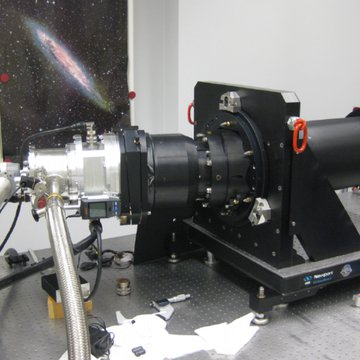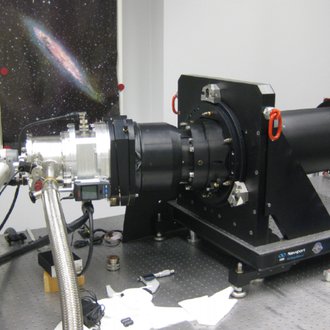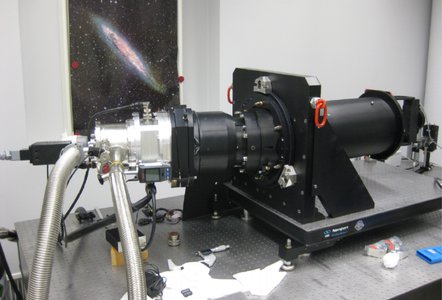Cancer Diagnostics with Astrophysics
Physicians and astrophysicists work on a new diagnostic method - Scientists from innoFSPEC Potsdam, a centre of innovative competence in the research field “Fibre-optical Spectroscopy and Sensing“ established at the Leibniz Institute for Astrophysics Potsdam (AIP), are working together with researchers of Charité Berlin on a new method of minimally invasive, optical cancer diagnostics.
The German Federal Ministry for Education and Research awarded project funding just under 1.5 Million Euros over a term of the next three years in order to adapt the technology and know-how from Astrophysics and make it accessible within Medicine.
The central research focus is Multichannel Multiplex Raman Spectroscopy. The Multiplex imaging technique is used within Astrophysics to simultaneously capture thousands of pixels in a single exposure. Currently, medicine’s only method of spectroscopic analysis is single-channel imaging. This method, however, requires an hour-long scan of the affected tissue. The cooperation between innoFSPEC and the Charité will change this. Scientist Silvia Adelhelm: „The optical diagnostic that the AIP will be researching during the next three years is tissue-conserving because it has higher picture quality and is faster than current methods. These methods therefore offer huge potential for resource-friendly as well as patient-friendly diagnostics.“
The goal is to modify one of the Multiplex-Spectrographs currently used for astrophysics for tissue diagnostics. Current optical techniques for cancer diagnostics like Confocal Laser Endoscopy or examination with the help of autofluorescence are not only time-consuming, but also require the extraction of tissue. Medical specialists would gladly forego such biopsies as they are unpleasant for the patient and are connected with risks of metastases. The scientists hope that the further development of Multiplex spectrographs, a proven method within Astrophysics for the past ten years, will allow the technology to be implemented in tissue diagnostics in the future.
In the western hemisphere, cancer is the second-largest cause of death. The course of the disease is often sorrowful. An early diagnosis is often connected to a very good prognosis, for which reason there is an acute need for the improvement of examination methods for prevention and tissue diagnostics. Following the validation of Multiplex Raman Spectroscopy as a suitable method for cancer diagnostics, the project leaders will strive towards the application of these advances within medical technology companies.
Science contact: Silvia Adelhelm, +49 331-7499 639, silvia.adelhelm@aip.de
Media contact: Kerstin Mork, +49 331-7499 469, presse@aip.de
Physicians and astrophysicists work on a new diagnostic method - Scientists from innoFSPEC Potsdam, a centre of innovative competence in the research field “Fibre-optical Spectroscopy and Sensing“ established at the Leibniz Institute for Astrophysics Potsdam (AIP), are working together with researchers of Charité Berlin on a new method of minimally invasive, optical cancer diagnostics.
The German Federal Ministry for Education and Research awarded project funding just under 1.5 Million Euros over a term of the next three years in order to adapt the technology and know-how from Astrophysics and make it accessible within Medicine.
The central research focus is Multichannel Multiplex Raman Spectroscopy. The Multiplex imaging technique is used within Astrophysics to simultaneously capture thousands of pixels in a single exposure. Currently, medicine’s only method of spectroscopic analysis is single-channel imaging. This method, however, requires an hour-long scan of the affected tissue. The cooperation between innoFSPEC and the Charité will change this. Scientist Silvia Adelhelm: „The optical diagnostic that the AIP will be researching during the next three years is tissue-conserving because it has higher picture quality and is faster than current methods. These methods therefore offer huge potential for resource-friendly as well as patient-friendly diagnostics.“
The goal is to modify one of the Multiplex-Spectrographs currently used for astrophysics for tissue diagnostics. Current optical techniques for cancer diagnostics like Confocal Laser Endoscopy or examination with the help of autofluorescence are not only time-consuming, but also require the extraction of tissue. Medical specialists would gladly forego such biopsies as they are unpleasant for the patient and are connected with risks of metastases. The scientists hope that the further development of Multiplex spectrographs, a proven method within Astrophysics for the past ten years, will allow the technology to be implemented in tissue diagnostics in the future.
In the western hemisphere, cancer is the second-largest cause of death. The course of the disease is often sorrowful. An early diagnosis is often connected to a very good prognosis, for which reason there is an acute need for the improvement of examination methods for prevention and tissue diagnostics. Following the validation of Multiplex Raman Spectroscopy as a suitable method for cancer diagnostics, the project leaders will strive towards the application of these advances within medical technology companies.
Science contact: Silvia Adelhelm, +49 331-7499 639, silvia.adelhelm@aip.de
Media contact: Kerstin Mork, +49 331-7499 469, presse@aip.de
Images
Spektrograph





